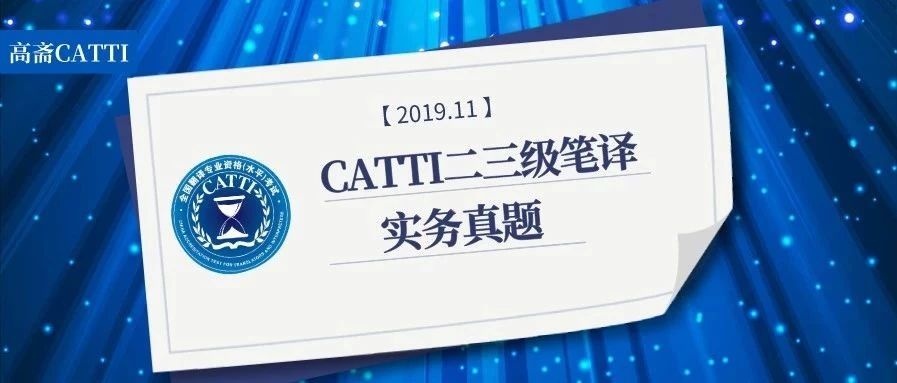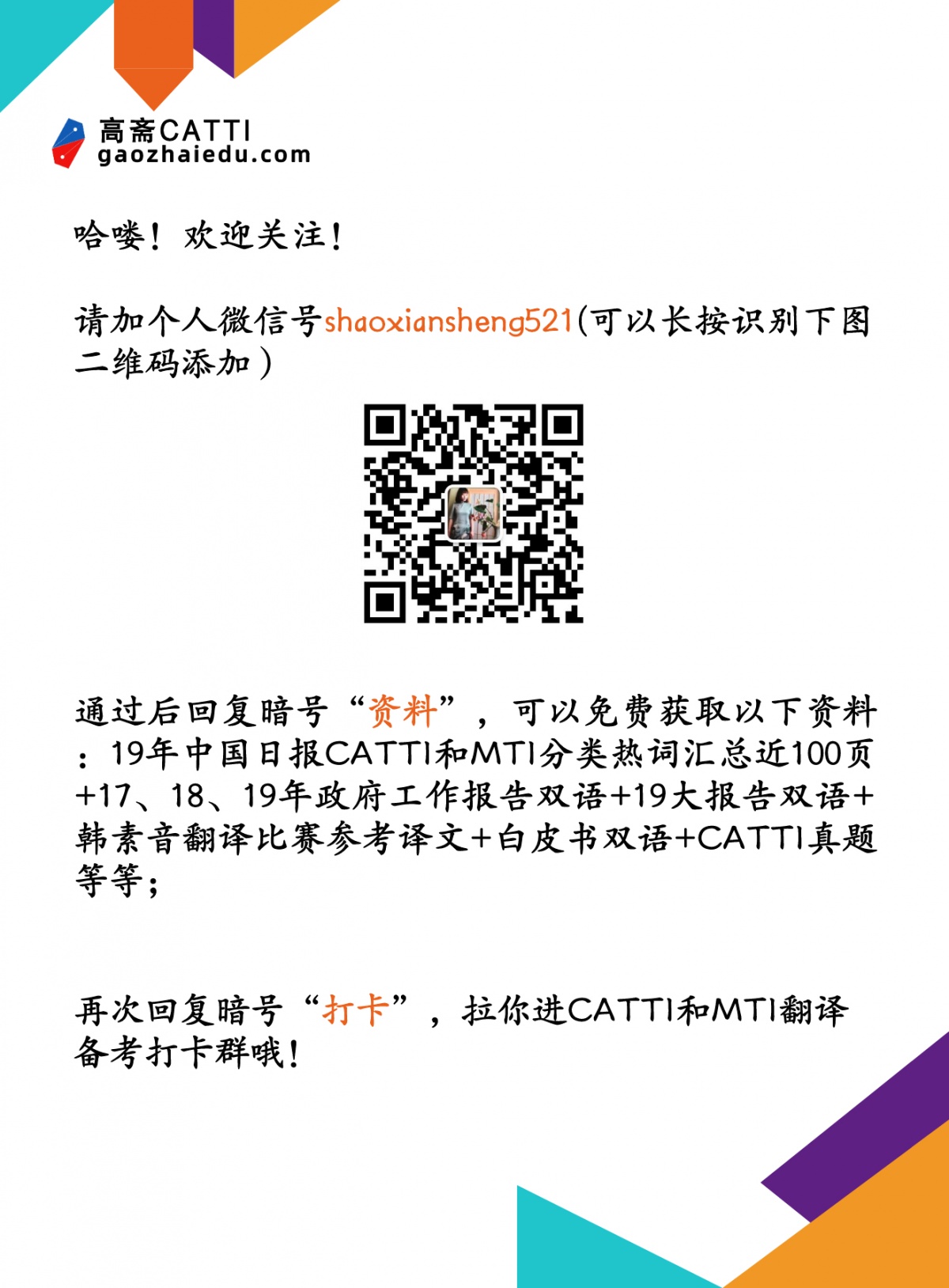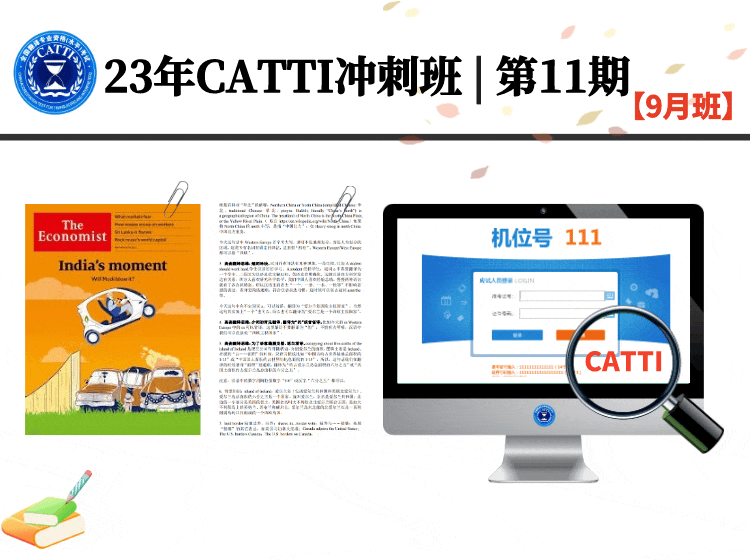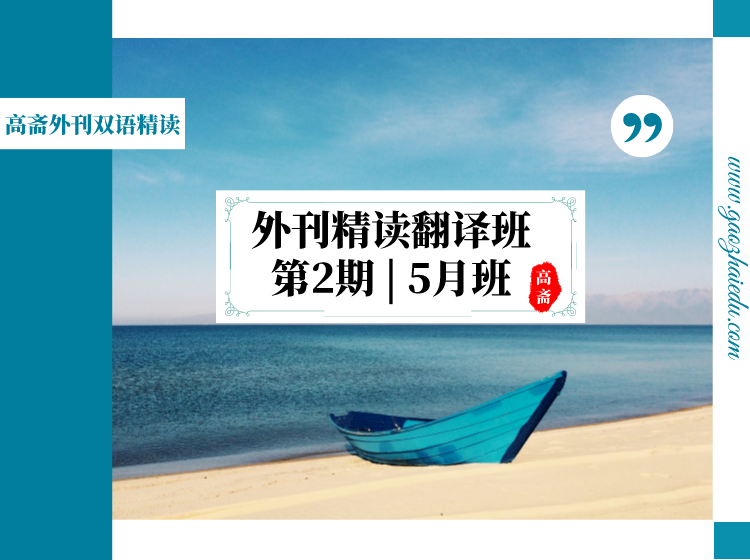更多精彩英语翻译内容,请关注公众号:高斋CATTI
19年11月CATTI二笔实务真题
回忆版本:
以下两篇文章都找到了原文出处,但是考试时并没有完全按照原文截取,所以我们按照真题内容进行了部分删减和修改。
内容均属于高斋学员回忆版,仅供参考,可能会与真题稍有出入,但相差不多。
01
英译汉第一篇:
节选自国际货币基金组织(IMF)总裁拉加德在第二届“一带一路”国际合作高峰论坛发表的演讲。
第一段:So where there is financial connection, we see that rapid improvements in quality of life can quickly follow. In our modern context, there are several important channels to achieving this greater financial connectivity. I want to highlight two today: increased capital mobility and increased financial inclusion.
哪里形成了金融联系,当地的生活质量就会很快改善。在现代背景下,更深层次的金融互联互通可以通过几个重要渠道来实现。我今天想强调两个渠道:加强资本流动和改善金融包容性。
第二段:First, enabling capital to flow more freely. Allowing capital to flow across borders can help support inclusive growth. Right now, foreign direct investment —FDI — is only 1.9 percent of GDP in developing countries. Before the global financial crisis, it was at 2.5 percent. Making progress on major infrastructure needs will require capital flows to rise again and to be managed safely. Greater openness to capital flows can also bring down the cost of finance, improve the efficiency of the financial sector, and allow capital to support productive investments and new jobs. Of course, there are also challenges that come with opening up capital markets. Thankfully, we know from experience the elements that are required for success. These include sound financial regulation, transparent rules for investment, and attention to fiscal sustainability.
第一,确保资本更自由地流动。允许资本跨境流动能帮助支持包容性增长。目前,发展中国家的外国直接投资(FDI)仅占GDP的1.9%;而在全球金融危机之前,这个数字是2.5%。为推进主要基础设施建设进展,需要再次增加资本流动规模,并以安全的方式对其进行管理。对资本流动更加开放也能降低融资成本,提高金融部门效率,允许资本支持生产性投资和新增就业。当然,资本市场开放也会带来挑战。幸运的是,我们从经验中获悉了成功所需的要素,包括完善的金融监管、透明的投资规则以及关注财政可持续性。
第三段:Second, We also need increased financial inclusion. A few numbers: close to half of the adult population in low and middle-income Asia-Pacific economies do not have a bank account. Less than 10 percent have ever borrowed from a financial institution. And yet, we know that closing the finance gap is an “economic must-have” for nations to thrive in the 21st century. IMF analysis shows that if the least financially inclusive countries in Asia narrowed the finance gap to the level of Thailand, the poverty rate in those countries could be reduced by nearly 4 percent. How can we get there? In part, through policies that enable more women and rural citizens to access financial services. The financial gender gap for women in developing countries is about 9 percent and has remained largely unchanged since 2011。
第二,我们还需要改善金融包容性。这里列举几个数字:亚太地区中低收入经济体近一半的成年人口没有银行账户。曾向金融机构借款的人口比重不到10%。然而我们知道,各国若要在21世纪繁荣发展,弥合金融缺口是一项“必须完成的经济任务”。国际货币基金组织的分析表明,如果亚洲金融包容性最弱的国家将金融缺口缩窄至泰国的水平,这些国家的贫困率能降低近4%。如何实现这一目标?一方面,制定能使更多妇女和农村居民获得金融服务的政策。在发展中国家,妇女面临的金融性别缺口约为9%,且自2011年来基本保持不变。
第四段:There is no quick fix, but we know that Fintech can play a catalyzing role. In Cambodia, for example, strong public-private partnerships in supporting mobile finance has led to a tripling in the number of micro-financial institutions since 2011. These institutions have now provided loans to over 2 million new borrowers, representing nearly 20 percent of the adult population. Many of these citizens had never had a bank account. Now they can save for the future and perhaps even start a business of their own.
这个问题没有快速解决之道,但我们知道金融科技能发挥催化作用。例如,柬埔寨通过强有力的公私合作关系支持移动金融发展,自2011年来微型金融机构的数量增加了两倍。目前,这些机构已向200多万个新借款者提供贷款,占成年人口的比重接近20%,这些公民很多从未开立银行账户。现在,他们可以通过储蓄规划未来,甚至也许可以自行创业。
第五段:These are ideas that can work everywhere. But countries have to be willing to partner and learn from each other. The IMF and World Bank launched the Bali Fintech Agenda last October, which lays out key principles — from developing financial markets to safeguarding financial integrity — that can help each nation as it strives for greater financial inclusion.
这些理念适用于所有国家,但这些国家必须有意愿开展合作并相互学习。国际货币基金组织和世界银行去年10月启动了“巴厘岛金融科技议程”。该议程阐述的核心原则——从发展金融市场到维护金融诚信——能帮助所有国家,因为其旨在改善金融包容性。
02
英译汉第二篇:
节选自Nasa to pretend asteroid is about to smash into Earth。
/uploads/allimg/191118/1133513W6-1.jpg
第一段:NASA is going to pretend a deadly asteroid is on its way, to practise for a real one. The “tabletop exercise” will allow the space agency and the other government organisations that will be tasked with responding to such an event to simulate their response, ahead of the possibility of a real example. The scenario will see a very realistic but nonetheless fictional disaster, in which an asteroid will be headed for Earth. The scenario has been developed by one of the Nasa organisations tasked with studying such near-earth objects, or NEOs. Such exercises are used across the disaster response sector, to ensure that the real responses are as fast and effective as possible.
第二段:“These exercises have really helped us in the planetary defense community to understand what our colleagues on the disaster management side need to know,” said Johnson, NASA’s Planetary Defense Officer. “This exercise will help us develop more effective communications with each other and with our governments.” Nasa and other organisations have spent more than 20 years scanning the skies for NEOs, looking for asteroids and comets that come within 30 million miles of Earth’s orbit. Groups such as Nasa’s Planetary Defense Coordination Office (PDCO行星防御协调办公室) as well as the European Space Agency’s Space Situational Awareness-NEO Segment(欧洲航天局空间态势感知近地天体部门) and the International Asteroid Warning Network (IAWN国际小行星预警系统) have been working to better communicate the danger that such objects pose to Earth.
第三段:There is no strict script in such an exercise. Instead, it will be used to test out how NEO observers, space agency officials, emergency managers, decision makers and citizens would respond to the threat of an impact. Those taking part will discuss possible preparations: how they would explore the asteroid, work out the best ways of deflecting it and dealing with its impact effects. Nasa has already participated in such exercises, working on some with the Federal Emergency Management Agency (FEMA). Those exercises brought representatives from a variety of different federal agencies, including the departments of Defense and State.
第四段:Previous exercises showed that the focus of emergency management officials was not on scientific details. Instead, they just want to know when, where and how an asteroid will hit the Earth, as well as what sort of damage is done. Nasa continues to work on that science, however, in an attempt to better improve humanity’s ability to predict the exact location and effects of any impact.
第五段:“NASA and FEMA will continue to conduct periodic exercises with a continually widening community of US government agencies and international partners,” said Lewis of the Response Operations Division for FEMA. “They are a great way for us to learn how to work together and meet each other’s needs and the objectives laid out in the White House National NEO Preparedness Action Plan.”
03
汉译英第一篇:
汉译英(人权)
这篇和《改革开放40年中国人权事业的发展进步》白皮书里面的内容很相似,类似话语用红色标出。内容均属于高斋学员回忆版,仅供参考,可能会与真题稍有出入,欢迎补充。
新中国的70年,是为中国人民谋幸福的70年,也是为世界人民谋发展的70年。新中国人权事业发展取得的巨大成就,有目共睹,永载史册。
In the 70 years since its founding, the PRC has been working for the wellbeing of the people, and also for global development. Its unprecedented achievements in human rights protection have been witnessed by all and will go down in history.
中国进一步建立并完善了适合本国国情的人权保障制度,初步形成了中国特色人权保障体系。
China has established and improved institutions for protecting human rights that are suited to its national conditions. A human rights protection system with Chinese characteristics has taken shape.
切实遵守国际人权义务。中国先后批准或加入了26项国际人权文书,其中包括《经济、社会及文化权利国际公约》《消除对妇女一切形式歧视公约》《消除一切形式种族歧视国际公约》等6项联合国核心人权条约。
Fulfilling obligations in the international instruments>倡导开展国际人权交流合作。中国高度重视开展人权领域对外交流交往与合作,致力于在相互尊重、开放包容、交流互鉴基础上开展建设性人权对话和人权磋商。自20世纪90年代起,中国陆续与20多个国家建立人权对话或磋商机制。
Advocating and conducting international exchanges and cooperation concerning human rights. China prioritizes communication, exchanges, and cooperation with other countries in the field of human rights, and is committed to conducting constructive dialogue and consultation mechanisms for human rights protection with more than 20 other countries.
中国在大力推进自身人权事业发展的同时,始终坚持平等互信、包容互鉴、合作共赢、共同发展的理念,积极参与联合国人权事务,认真履行国际人权义务,广泛开展国际人权合作,积极为全球人权治理提供中国智慧、中国方案,以实际行动推进全球人权治理朝着更加公正合理包容的方向发展。
While promoting the development of its own human rights, China upholds the principles of equality and mutual trust, inclusiveness and mutual learning, cooperation and mutual benefits, and common development. It has been active in UN human rights undertakings, fulfills its international human rights obligations, conducts extensive international cooperation on human rights, actively offers Chinese wisdom and solutions for global governance of human rights, and advances through concrete actions the global governance of human rights in a fairer, more rational and inclusive direction.
助力发展中国家经济社会发展。中国注重推动广大发展中国家人民生存权、发展权的实现,长期在基础设施及教育、卫生、农业等领域向亚洲、非洲、拉丁美洲等的发展中国家和地区提供支援和帮助。
Supporting economic and social development in other developing countries. To help the peoples of developing countries to realize their rights to subsistence and development, China has long provided assistance to other developing countries and regions in Asia, Africa, and Latin America in such fields as infrastructure, education, healthcare and agriculture.
新中国成立70年来,人权取得巨大成就。新中国成立之初,教育水平低,人口文化素质差,小学净入学率和初中毛入学率仅分别为20%和3%,高校在校生仅有11.7万人,全国80%的人口是文盲。中国将人权纳入宪法,得到了国际社会广泛认可。
Universal education expands remarkably. In the early days of the PRC, China’s education system was poor and the general level of education was low. The net primary education enrolment rate was 20 percent and the gross junior secondary education enrolment rate was only 3 percent. There were only 117,000 college students and 80 percent of the population was illiterate. Human rights have made their way into the Chinese Constitution, which has received wide recognition of the international community.
04
汉译英第二篇:
(传统民居建筑)欢迎大家补充
中国幅员辽阔,在漫长的历史中,逐渐形成了多种多样、各具地方特色的传统民居建筑。
传统民居建筑具有鲜明的地域特色。就读于建筑专业的毛葛开始研究传统民居建筑。她意识到,每一座传统民居建筑都是工匠们忘我劳动的成果。从这些建筑中,她感觉到了过去的中国人对自己生活的深深热爱。
80年代,城镇化进程加快,很多传统民居建筑减少;传统的建造技艺、建房工具、建筑知识等逐渐被人们冷落。出生于80年代的毛葛热爱漫画,她希望有更多人尤其是年轻人了解到传统民居建筑的美并开始保护它们。
她写了一本书,用有趣的漫画和通俗易懂的文字,向人们介绍了传统民居建筑,展现了中国人民的居住文化。
19年11月CATTI三笔实务真题
01
英译汉:
英译汉内容有多,学员回忆的时候忘记如何删除了,感谢高斋学员回忆。
出处:
/uploads/allimg/191118/11335155T-2.jpg联合国教科文组织
In today’s interconnected world, culture's power to transform societies is clear. Its diverse manifestations – from our cherished historic monuments and museums to traditional practices and contemporary art forms – enrich our everyday lives in countless ways. Heritage constitutes a source of identity and cohesion for communities disrupted by bewildering change and economic instability. Creativity contributes to building open, inclusive and pluralistic societies. Both heritage and creativity lay the foundations for vibrant, innovative and prosperous knowledge societies.
Culture is who we are and what shapes our identity. No development can be sustainable without including culture. UNESCO ensures that the role of culture is recognized through a majority of the Sustainable Development Goals (SDGs), including those focusing on quality education, sustainable cities, the environment, economic growth, sustainable consumption and production patterns, peaceful and inclusive societies, gender equality and food security. UNESCO is convinced that no development can be sustainable without a strong culture component.
To ensure that culture takes it rightful place in development strategies and processes, UNESCO has adopted a three-pronged approach: it spearheads worldwide advocacy for culture and development, while engaging with the international community to set clear policies and legal frameworks and working on the ground to support governments and local stakeholders to safeguard heritage, strengthen creative industries and encourage cultural pluralism.
To ensure that culture takes it rightful place in development strategies and processes, UNESCO has adopted a three-pronged approach: it spearheads worldwide advocacy for culture and development, while engaging with the international community to set clear policies and legal frameworks and working on the ground to support governments and local stakeholders to safeguard heritage, strengthen creative industries and encourage cultural pluralism.
Today, creativity is emerging as one of the most promising avenues for changing how we see cities. Whether by revitalizing the local economy, rethinking transport or housing policies, reclaiming urban spaces, or opening up new horizons for young people, creativity is one of the driving forces behind urban policies and initiatives. Cities worldwide are focusing their attention on the cultural and creative industries as an inspiration for their future. This vision is promoted by elected representatives and city policy-makers, who see it as a strategic lever for innovation when it comes to tackling contemporary urban issues, whether on an economic, social or environmental front. More importantly, however, it is a vision shared by professionals and citizens, who are taking action in their own neighborhoods and communities to build more sustainable and more human cities.
This vision of creative urban governance is the driving force behind the UNESCO Creative Cities Programme and Network(联合国教科文组织创意城市网络). Since its creation in 2004, the Network has established itself as a strategic platform for promoting and sharing this new approach to sustainable cities. Through its standard-setting and operational actions, UNESCO has paved the way for demonstrating the essential role of creativity in urban sustainability, assisting national and local authorities and advocating this vision at an international level.
Culture and creativity play a key role in sustainable urban development. They contribute to diversifying the economy and generating jobs but they also enhance the quality of life of citizens by participating to a city’s social structure and cultural diversity.
02
汉译英:
汉译英 欢迎补充
出处:每个地方挑选的,有的出自官方教程,有的出自G20峰会杭州介绍。感谢学员提供部分回忆内容。
作为中国浙江省省会,杭州是中国历史文化名城。距今约5300年的“良诸文化”遗址(位于杭州余杭区)是中华文明发祥地之一。
杭州素以美丽的山水著称。中国古代有句谚语,“上有天堂,下有苏杭”,表达了古往今来人们对这座美丽城市的由衷喜爱。
西湖位于杭州市西南方,以其秀丽的湖光山色和众多的名胜古迹而成为闻名中外的旅游胜地。2011年被正式列入《世界遗产名录》。此外,气势浩荡的钱江大潮,每年吸引无数游客。
杭州拥有丰富的历史文化遗迹。南起杭州、北到北京的京杭大运河始建于1631年,全长约1797公里,是世界上最长、最古老的人工水道。2014年6月22日,京杭大运河正式列入《世界遗产名录》。
在世界,杭州颇具名声。早在 13 世纪,意大利著名旅行家马可波罗赞杭州为“世界上最美丽之城”。杭州曾被美国《纽约时报》评为“2011年全球最值得去的41个地方”,还被联合国环境规划署评为“国际花园城市”。
杭州还曾在中美建交过程中扮演过重要角色。2015年1月,中国提出“旅游外交”政策。杭州作为著名旅游城市,又率先实施“旅游外交”。
如果你阅读完本文有所收获,
更多精彩英语翻译内容,请关注公众号:高斋CATTI


|
19年11月CATTI二三笔实务真题汇总和部分参考译文
文章来源:高斋CATTI
发布时间:2019-11-18 11:33
作者:高斋CATTI
点击:次
|






